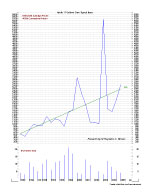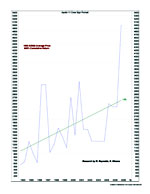|
|

|
Reynolds-Winans Apollo Collectible Index™
by Dr. Michael Reynolds and Ken Winans
Introducing the first investment index devoted to tracking Apollo 11 autographed piece values from 1993 to present.
Why an index for space collectibles?
Just as a stock investor relies on the S&P 500 Index or the Dow Jones Industrial Average to track the overall stock market, collectors need a gauge to broadly monitor their investments.
History of the RWACI
Insurance companies traditionally need an established benchmark to measure the appreciation of collectibles. For example, art collectors have indices that track the historical values of Monet's and Picasso's art. For space collectibles, collectors are "flying blind" due to the lack of a similar index. To date, no one is known to have offered a space collectible index to the public.
The RWACI is important and timely because:
- Apollo 11 collectibles are trading near 13-year high valuations;
- The RWACI shows that space collectibles have appreciated well and allows for a direct comparison of returns with more conventional investments. RWACI's Apollo 11 Portrait Component has had a cumulative return of 355% since January 1993;
Space Collecting Basics
SInce their introduction to the auction world in the early 1990's, space collectibles have exhibited characteristics that are unique when compared to other interests' similar items:
International Appeal - Space exploration has always enjoyed worldwide popularity and this corresponds to a global appeal for its collectibles, whereas with areas of other interest they are limited by national boundaries;
Finite Supply of Items - There is a relatively limited number of space explorers and associated, significant artifacts. The fact that only 24 men have departed low earth orbit for the Moon, and that the general public is only allowed possession of certain items that have made the same journey, make the laws governing supply and demand very relevant;
"Baby Boomer"-Type of Collectible - The "baby boom" generation were children during the space race, making space collectibles an easy hobby to embrace as many collectors focus on what they remember from their youth;
Multiple Dimensions - There are numerous types of items that a space collector can choose from to purchase (in various price ranges) such as: autographs, books, flown items, documents, photographs, art, models, toys, etc.;
Research and Index Construction
Data Used - Sale results were gathered from the past auctions of Superior Galleries, Aurora Auctions, Swann Auction Galleries and Christie's from 1993 to the present. At this time, internet-only auctions (i.e. eBay, Yahoo, etc.) are excluded as access to data older than 30 days remains unavailable.
Data Examination - Identification of items for an even-weighted index resulted in a focus on collectibles that consistently appeared for sale during the timeframe cited that also had an associated high degree of authenticity. Purchase prices were carefully screened for inaccuracies or unexplained, non-confirmed discrepancies.
Final Selection Process - After review, the decision was made to focus on Apollo 11 crew signed items based on the following criteria:
- Consistency - These items appeared regularly offered at auctions and were actively bid upon. Many auctions offered multiple lots of the same items for sale in a single catalog.
- Authenticity - It is easier to evaluate the validity of autographs as compared to other collectibles. Further, as Neil Armstrong rarely signs autographs today, it is also easier to track the history of the items sold.
- Popularity - Generally speaking, Apollo 11 items are some of the most popular items for sale at an auction and command the best prices. For this index, if an item is absent from an auction, then the prices from the prior auction are used (i.e. Last Sale Price).
Exclusion from the Index - An item is removed from the index if its price was unexplainably high or low and could not be confirmed by other sales. Signed flown items, considered to be another category from autographs alone, were also excluded.
Applications
The RWACI has two components:
- The Apollo 11 Crew-Signed Portrait Index
- The Apollo 11 Crew-Signed Items Index
These can be used in several ways, for example:
- Establishes a Long-term Appreciation Rate - These collectibles have appreciated well in value. They have performed better than the S&P 500 Stock Index. This data is useful for insurance or estate planning purposes.
- Timing Purchases and Sales - This data can help collectors determine periods of over and under valuation to determine whether it is a good time to buy or sell items and at what price.
RWACI Use & Licensing - The RWACI is trademark pending. This report and its methodologies are copyright protected against unauthorized duplication.
Currently, use of the RWACI is free of charge but must have prior approval. The data is formatted for Meta Stock Charting and spreadsheet software.
Past performance should not be taken as representative of future results.
The information supplied and formula calculations used are considered reliable but cannot be guaranteed.
Numbers can change without notice.
|

© 2022 collectSPACE.com All rights reserved.
Questions? E-mail contact@collectspace.com
|
|

|
Click on charts to download PDF-format enlargements.

Unflown Crew Signed Items
(1993-2005 Average Prices)

Crew Signed Portrait
(1993-2006 Average Prices)
This analysis was prepared in September 2005 by:
Dr. Mike Reynolds, President, Out of This World Appraisals - Dr. Reynolds has spent thirty years in astronomy and space sciences in the roles of a high school and university instructor, planetarium and museum director, researcher, writer and lecturer. He has received numerous recognitions for his work, including the 1986 Florida State Teacher of the Year and NASA Teacher-in-Space National Finalist. Reynolds has written a number of astronomy books and articles and is just completing his fifth book about using binoculars for astronomy. He has also led numerous expeditions worldwide and has also served as an invited speaker internationally. Reynolds is Executive Director Emeritus of the Chabot Space & Science Center in Oakland, California and is currently a college astronomy professor.
Ken Winans, President & Founder, Winans International Investment Management - For over 24 years, Ken Winans has conducted extensive investment analyses and designed innovative investment models and strategies. He is a regular guest on various TV and radio shows and has had much of his investment research published by leading magazines and newspapers worldwide. He served as adjunct faculty member of the Graduate School of Business at St. Mary's College of California from 1996 to 2001. In 2004, Ken founded The W Foundation, a non-profit organization dedicated to the public education of the history and future benefits of space exploration.
|

|


